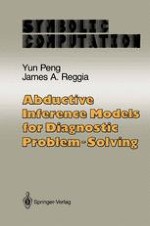1990 | OriginalPaper | Buchkapitel
Parallel Processing for Diagnostic Problem-Solving
verfasst von : Yun Peng, James A. Reggia
Erschienen in: Abductive Inference Models for Diagnostic Problem-Solving
Verlag: Springer New York
Enthalten in: Professional Book Archive
Aktivieren Sie unsere intelligente Suche, um passende Fachinhalte oder Patente zu finden.
Wählen Sie Textabschnitte aus um mit Künstlicher Intelligenz passenden Patente zu finden. powered by
Markieren Sie Textabschnitte, um KI-gestützt weitere passende Inhalte zu finden. powered by
In the probabilistic causal model described in this book, as well as in some others, probabilistic inference is combined with AI symbol processing methods for diagnostic problem-solving. In these models disorders and manifestations (and perhaps intermediate states) are connected by causal links associated with probabilities representing the strength of causal association. A hypothesis, consisting of zero or more disorders, with the highest posterior probability under the given set of manifestations (findings) is typically taken as the optimal problem solution. Conventional sequential search approaches in AI for solving diagnostic problems formulated in this fashion, such as the ones presented in Chapter 5 of this book and the search algorithm in NESTOR [Cooper84], suffer from combinatorial explosion when the number of possible disorders is large. This is because they potentially must compare the posterior probabilities of all or a notable portion of possible combinations of disorders. Pearl’s belief network model adopts a parallel revision method to find global optimal solutions for the special case of singly-connected causal networks within polynomial time of the network diameter [Pearl87]. However, as discussed in Section 5.4, for a non-singly-connected causal network, which is the case for most diagnostic problems, Pearl’s approach requires separate computation for each instantiation of the set of “cycle-cut” nodes, and thus still leads to combinatorial difficulty when this set of cycle-cut nodes is large. All of these problems raise the issue of whether the probabilistic causal model described in this book might be formulated as a highly parallel computation, i.e., as a “connectionist model”, so that combinatorial explosion can be avoided.
